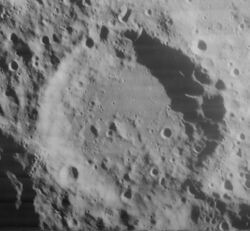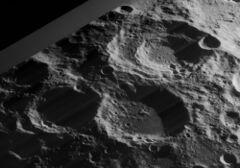Astronomy:Helmholtz (lunar crater)
 Lunar Orbiter 4 image | |
| Diameter | 110.16 km |
|---|---|
| Colongitude | 300° at sunrise |
Helmholtz is a lunar impact crater, approximately 110 kilometers in diameter, that is located near the south-southeast limb of the Moon. Attached to the south-southeast rim of Helmholtz is the somewhat smaller crater Neumayer. The larger crater Boussingault is nearly attached to the west-southwestern rim. The crater is named after German physicist and physician Hermann von Helmholtz[1]
Description
The outer rim of Helmholtz is worn and rounded, although not significantly disrupted. The edge of the rim can still be discerned around the perimeter, although several small craters lie along the inner edge. One such crater lies across the inner southeast wall, and a pair occupies the opposite inner wall to the northeast. There are also a couple of smaller craterlets just inside the north rim.
The northern half of the interior floor is level and marked only by a few very tiny craterlets. The southern floor is more irregular due to the overlaying ejecta from Neumayer and Boussingault, and is marked by a pair of tiny craters in the southeast. There is no central peak.
Satellite craters
By convention these features are identified on lunar maps by placing the letter on the side of the crater midpoint that is closest to Helmholtz.
| Helmholtz | Latitude | Longitude | Diameter | Ref |
|---|---|---|---|---|
| A | 64.4° S | 51.5° E | 15.98 km | WGPSN |
| B | 67.8° S | 68.4° E | 11.83 km | WGPSN |
| D | 66.3° S | 54.3° E | 44.59 km | WGPSN |
| F | 64.3° S | 60.1° E | 50 km | WGPSN |
| H | 64.5° S | 65.2° E | 19.83 km | WGPSN |
| J | 64.8° S | 67.8° E | 23.02 km | WGPSN |
| M | 65.2° S | 51.1° E | 24.31 km | WGPSN |
| N | 64.8° S | 50.1° E | 13.53 km | WGPSN |
| R | 63.5° S | 54.7° E | 12.21 km | WGPSN |
| S | 64.3° S | 56.6° E | 31.67 km | WGPSN |
| T | 65.7° S | 59.7° E | 30.53 km | WGPSN |
See also
- 11573 Helmholtz, asteroid
References
- ↑ "Helmholtz (lunar crater)". Gazetteer of Planetary Nomenclature. USGS Astrogeology Research Program.
- Andersson, L. E.; Whitaker, E. A. (1982). NASA Catalogue of Lunar Nomenclature. NASA RP-1097.
- Blue, Jennifer (July 25, 2007). "Gazetteer of Planetary Nomenclature". USGS. http://planetarynames.wr.usgs.gov/.
- Bussey, B.; Spudis, P. (2004). The Clementine Atlas of the Moon. New York: Cambridge University Press. ISBN 978-0-521-81528-4.
- Cocks, Elijah E.; Cocks, Josiah C. (1995). Who's Who on the Moon: A Biographical Dictionary of Lunar Nomenclature. Tudor Publishers. ISBN 978-0-936389-27-1. https://archive.org/details/isbn_9780936389271.
- McDowell, Jonathan (July 15, 2007). "Lunar Nomenclature". Jonathan's Space Report. http://host.planet4589.org/astro/lunar/.
- Menzel, D. H.; Minnaert, M.; Levin, B.; Dollfus, A.; Bell, B. (1971). "Report on Lunar Nomenclature by the Working Group of Commission 17 of the IAU". Space Science Reviews 12 (2): 136–186. doi:10.1007/BF00171763. Bibcode: 1971SSRv...12..136M.
- Moore, Patrick (2001). On the Moon. Sterling Publishing Co. ISBN 978-0-304-35469-6. https://archive.org/details/patrickmooreonmo00patr.
- Price, Fred W. (1988). The Moon Observer's Handbook. Cambridge University Press. ISBN 978-0-521-33500-3.
- Rükl, Antonín (1990). Atlas of the Moon. Kalmbach Books. ISBN 978-0-913135-17-4.
- Webb, Rev. T. W. (1962). Celestial Objects for Common Telescopes (6th revised ed.). Dover. ISBN 978-0-486-20917-3. https://archive.org/details/celestialobjects00webb.
- Whitaker, Ewen A. (1999). Mapping and Naming the Moon. Cambridge University Press. ISBN 978-0-521-62248-6.
- Wlasuk, Peter T. (2000). Observing the Moon. Springer. ISBN 978-1-85233-193-1.
 |


